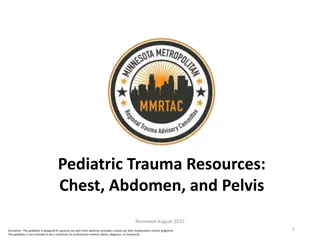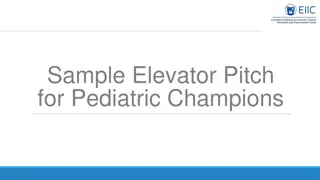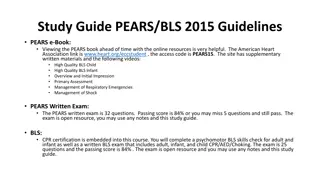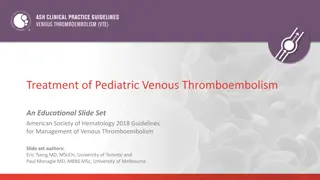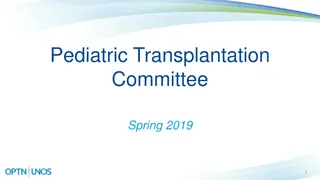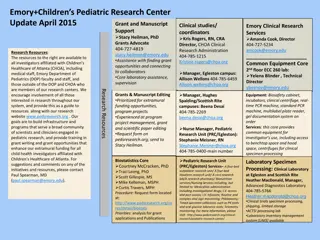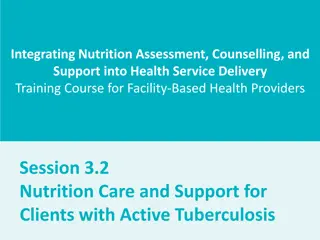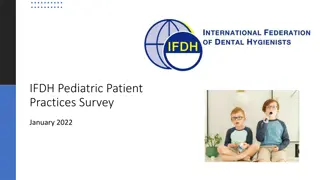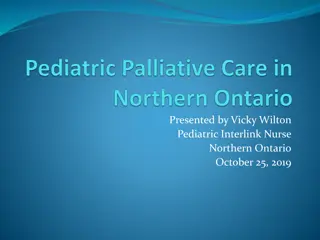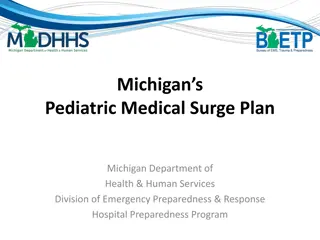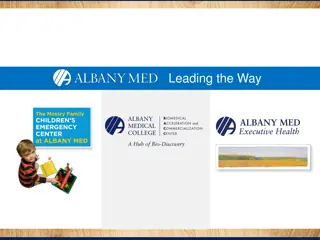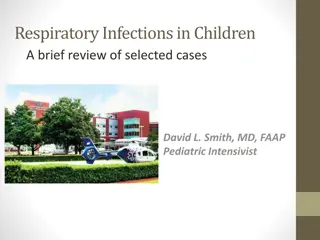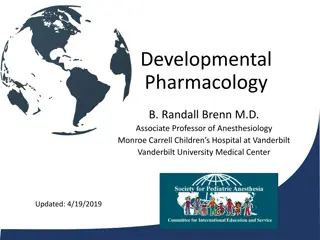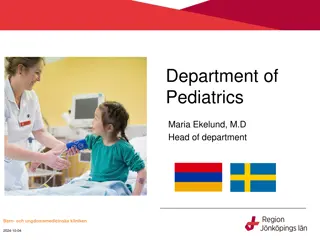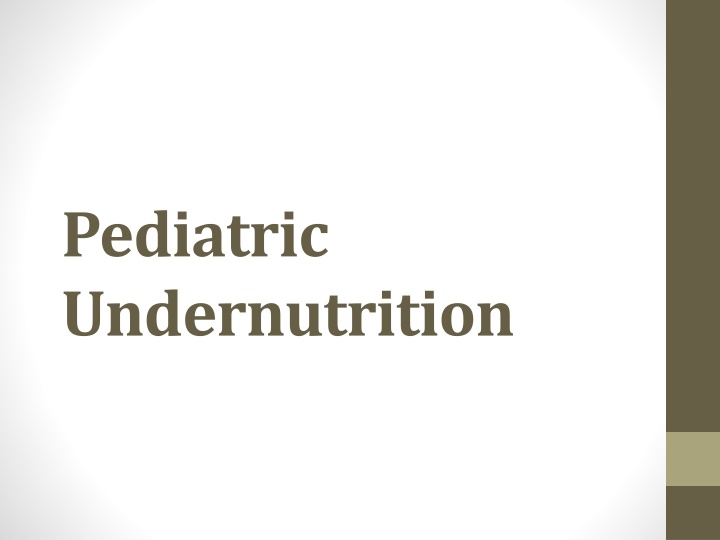
Pediatric Undernutrition in Children
Pediatric undernutrition, often due to inadequate food supply or health access, poses significant risks to child development. Protein-energy malnutrition (PEM) and failure to thrive are common issues in undernourished children. Recognizing and addressing these conditions is crucial to prevent severe consequences like physical disability and even death. Educating parents and caregivers on proper nutrition and health practices is key to combating pediatric undernutrition.
Download Presentation

Please find below an Image/Link to download the presentation.
The content on the website is provided AS IS for your information and personal use only. It may not be sold, licensed, or shared on other websites without obtaining consent from the author. If you encounter any issues during the download, it is possible that the publisher has removed the file from their server.
You are allowed to download the files provided on this website for personal or commercial use, subject to the condition that they are used lawfully. All files are the property of their respective owners.
The content on the website is provided AS IS for your information and personal use only. It may not be sold, licensed, or shared on other websites without obtaining consent from the author.
E N D
Presentation Transcript
Pediatric Undernutrition
Pediatric undernutrition is usually the result of inadequate food supply, access, or utilization; poor access to health and sanitation; chronic health conditions; and/or inappropriate feeding or child-care practices. The greatest risk of undernutrition is in utero through age 2 years. Other measurements include height and weight for age, weight for height, BMI, and mid-upper arm circumference. The greatest consequence of undernutrition is death, but significant intellectual and physical disability exists in many who survive.
Protein-energy malnutrition (PEM) is a spectrum of conditions caused by varying levels of protein and calorie deficiencies. Primary PEM is caused by social or economic factors that result in a lack of food. Secondary PEM occurs in children with various conditions associated with increased caloric requirements (infection, trauma, cancer;), increased caloric loss (malabsorption), reduced caloric intake (anorexia, cancer, oral intake restriction, social factors), or a combination of these three variables. Protein and calorie malnutrition may be associated with other nutrient deficiencies, which may be evident on physical examination
Failure to Thrive Pediatric undernutrition in the United States is often termed failure to thrive and describes circumstances in which a child fails to gain weight appropriately or, in more severe cases, experiences failure in linear growth or head circumference. The terms organic and nonorganic failure to thrive have lost favor in recognition of the frequent interplay between underlying medical conditions that may cause maladaptive behaviors. Similarly, social and behavioral factors that initially may have been associated with feeding problems and poor growth may also be associated with medical problems, including frequent minor acute illnesses
Marasmus Marasmus results from the body's physiologic response to inadequate calories and nutrients. Loss of muscle mass and subcutaneous fat stores can be confirmed by inspection or palpation and quantified by anthropometric measurements. The head may appear large but generally is proportional to the body length. Edema usually is absent. The skin is dry and thin, and the hair may be thin, sparse, and easily pulled out. Marasmic children may be apathetic and weak and may be irritable when touched. Bradycardia and hypothermia signify severe and life-threatening malnutrition. Inappropriate or inadequate weaning practices and chronic diarrhea are common findings in developing countries. Stunting (impaired linear growth) results from a combination of malnutrition, especially micronutrients, and recurrent infections.
Kwashiorkor Kwashiorkor results from inadequate protein intake in the presence of fair to good caloric intake. The hypoalbuminemic state results in pitting edema that starts in the lower extremities and ascends with increasing severity. Other factors, such as acute infection, toxins, and possibly specific micronutrient or amino acid imbalances, are likely to contribute to the etiology. The major clinical manifestation of kwashiorkor is that the body weight is near normal for age; weight alone does not accurately reflect the nutritional status because of edema. Physical examination reveals a relative maintenance of subcutaneous adipose tissue and a marked atrophy of muscle mass. Edema varies from a minor pitting of the dorsum of the foot to generalized edema with involvement of the eyelids and scrotum.
The hair is sparse, easily plucked, and appears dull brown, red, or yellow-white. Nutritional repletion restores hair color, leaving a band of hair with altered pigmentation followed by a band with normal pigmentation (flag sign). Skin changes are common and range from hyperpigmented hyperkeratosis to an erythematous macular rash (pellagroid) on the trunk and extremities. In the most severe form of kwashiorkor, a superficial desquamation occurs over pressure surfaces ( flaky paint rash). Angular cheilosis, atrophy of the filiform papillae of the tongue, and monilial stomatitis are common.
Enlarged parotid glands and facial edema result in moon facies; apathy and disinterest in eating are typical of kwashiorkor. Examination of the abdomen may reveal an enlarged, soft liver with an indefinite edge. Lymph node and tonsils are commonly atrophic. Chest examination may reveal basilar rales. The abdomen is distended, and bowel sounds tend to be hypoactive.
Mixed Marasmus- Kwashiorkor These children often have concurrent wasting and edema in addition to stunting. These children exhibit features of dermatitis, neurologic abnormalities, and fatty liver.
Treatment of Malnutrition The basal metabolic rate and immediate nutrient needs decrease in cases of malnutrition. The body of the malnourished child may have compensated for micronutrient deficiencies with lower metabolic and growth rates, and refeeding may unmask these deficiencies. Nutritional rehabilitation should be initiated and advanced slowly to minimize these complications. The initial approach involves correction of dehydration and antiinfective (bacteria, parasites) therapy if indicated. Oral rehydration is recommended over intravenous fluid to avoid excessive fluid and solute load and resultant heart or renal failure.
When nutritional rehabilitation is initiated, calories can be safely started at 20% above the child's recent intake. If no estimate of the caloric intake is available, 50-75% of the normal energy requirement is safe. High-calorie oral solutions or ready-to-use therapeutic foods (a mixture of powdered milk, peanuts, sugar, vitamins, and minerals) are frequently used in developing countries. Nutritional rehabilitation can be complicated by refeeding syndrome, which is characterized by fluid retention, hypophosphatemia, hypomagnesemia, and hypokalemia. Careful monitoring of laboratory values and clinical status with severe malnutrition is essential.
When nutritional rehabilitation has begun, caloric intake can be increased 10-20% per day, monitoring for electrolyte imbalances, poor cardiac function, edema, or feeding intolerance. If any of these occurs, further caloric increases are not made until the child's status stabilizes. Caloric intake is increased until appropriate regrowth or catch-up growth is initiated. Catch-up growth refers to gaining weight at greater than 50th percentile for age and may require 150% or more of the recommended calories for an age-matched, well nourished child. A general rule of thumb for infants and children up to 3 years of age is to provide 100-120 kcal/kg based on ideal weight for height.
Protein needs also are increased as anabolism begins and are provided in proportion to the caloric intake. Vitamin and mineral intake in excess of the daily recommended intake is provided to account for the increased requirements; this is frequently accomplished by giving an age-appropriate daily multiple vitamin with other individual micronutrient supplements as warranted by history, physical examination, or laboratory studies. Iron supplements are not recommended during the acute rehabilitation phase, especially for children with kwashiorkor, for whom ferritin levels are often high. Additional iron may pose an oxidative stress; iron supplementation at this time is associated with higher morbidity and mortality. In most cases, cow's milk based formulas are tolerated and provide an appropriate mix of nutrients. If feeding intolerance occurs, lactose-free or semi-elemental formulas should be considered
Complications of Malnutrition Malnourished children are more susceptible to infection, especially sepsis, pneumonia, and gastroenteritis. Hypoglycemia is common after periods of severe fasting but may also be a sign of sepsis. Hypothermia may signify infection or, with bradycardia, may signify a decreased metabolic rate to conserve energy. Bradycardia and poor cardiac output predispose the malnourished child to heart failure, which is exacerbated by acute fluid or solute loads. Micronutrient deficiencies also can complicate malnutrition.
Vitamin A and zinc deficiencies are common in the developing world and are an important cause of altered immune response and increased morbidity and mortality. Depending on the age at onset and the duration of the malnutrition, malnourished children may have permanent growth stunting (from malnutrition in utero, infancy, or adolescence) and delayed development (from malnutrition in infancy or adolescence). Environmental (social) deprivation may interact with the effects of the malnutrition to impair further development and cognitive function.


